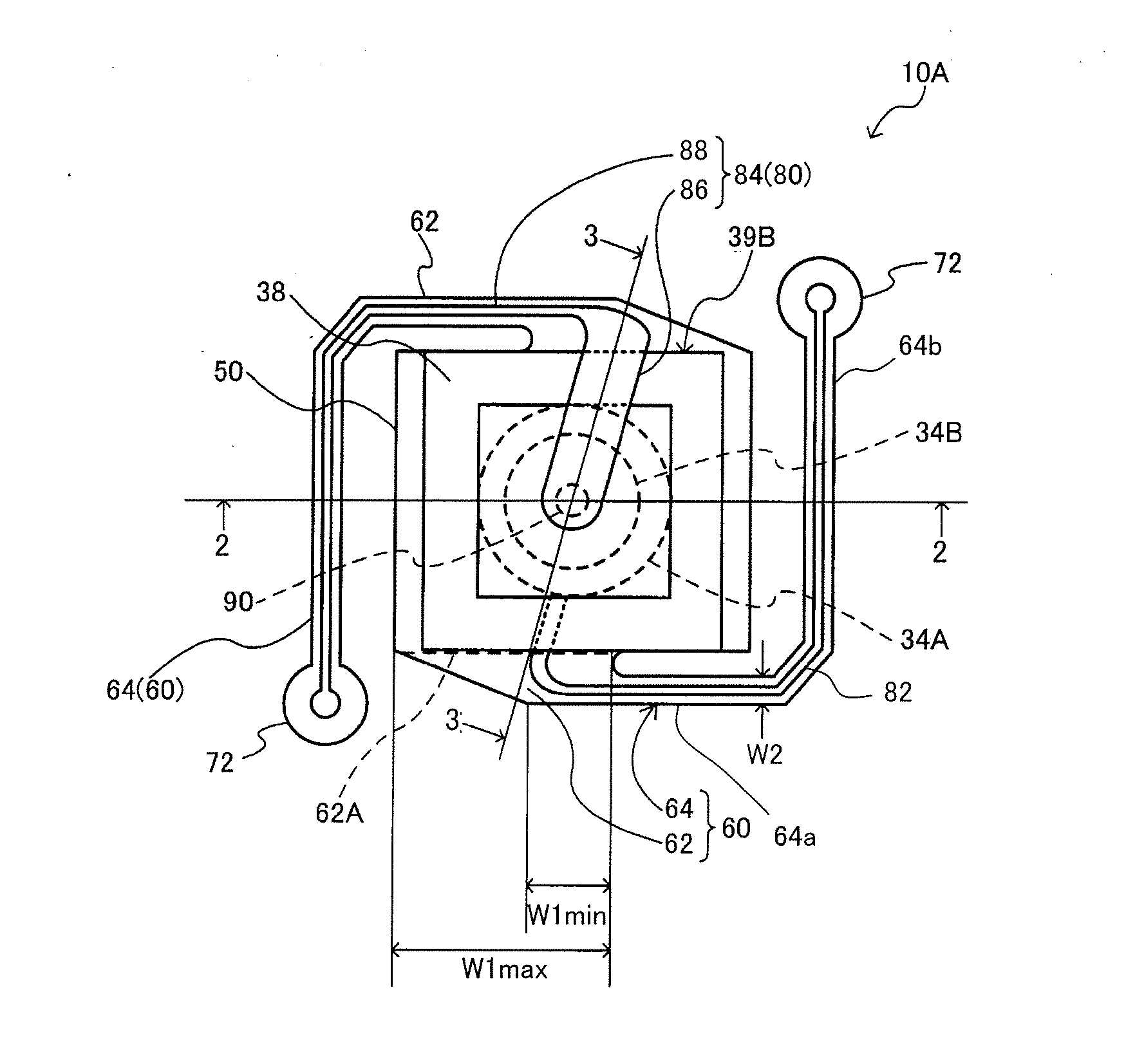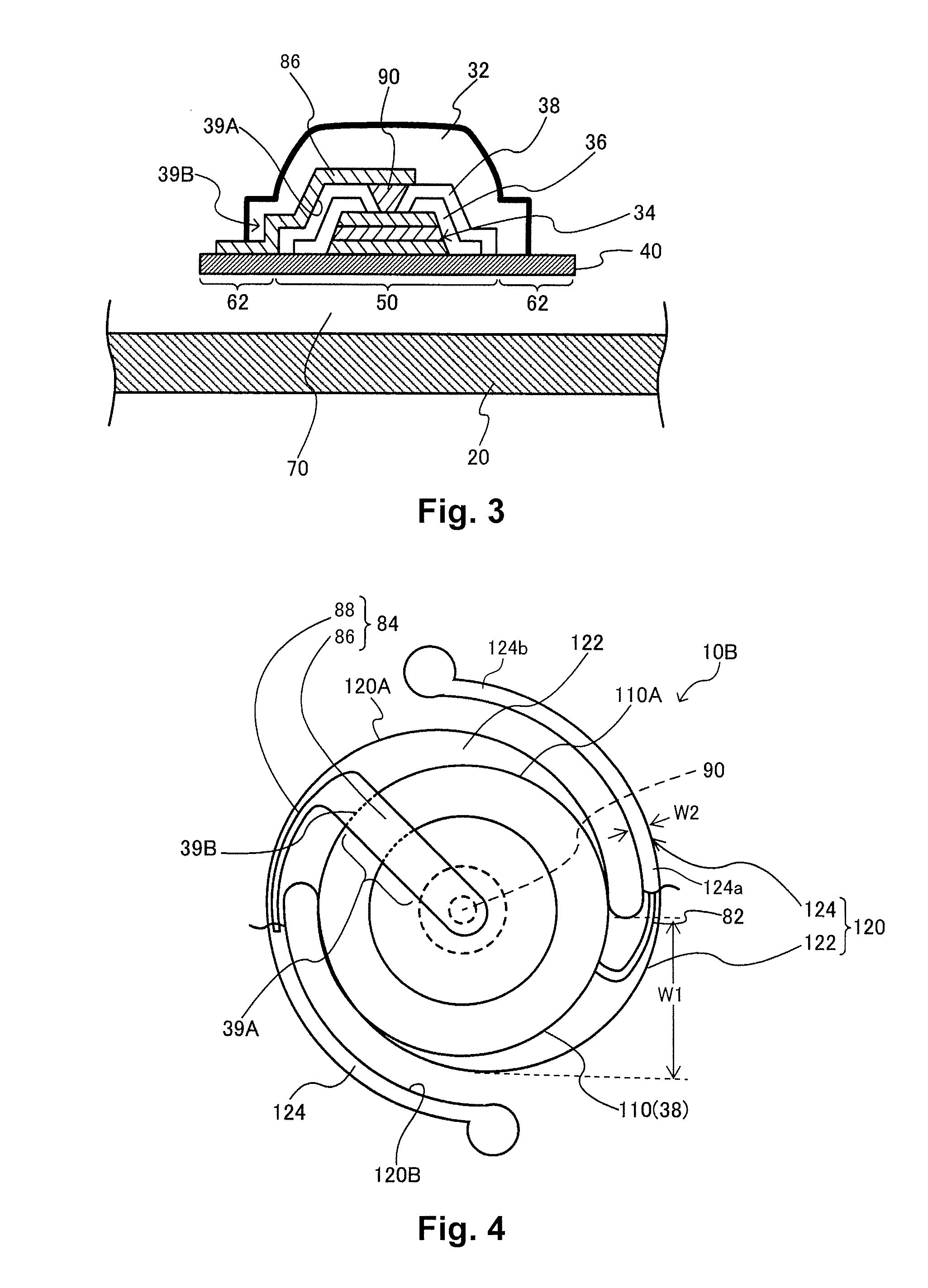Thermal detector, thermal detecting device, and electronic instrument
a technology of thermal detection and electronic instruments, applied in the direction of instruments, heat measurement, optical radiation measurement, etc., can solve the problems of difficult to form the shape of a step-shaped change or an undercut in a cross-sectional view, the support arm will not have sufficient strength, and the light capture efficiency to decline, etc., to achieve the effect of easy to achiev
- Summary
- Abstract
- Description
- Claims
- Application Information
AI Technical Summary
Benefits of technology
Problems solved by technology
Method used
Image
Examples
first embodiment
1. First Embodiment
1.1. Overall Structure of Infrared Detector
[0042]FIG. 1 is a plan view of an infrared detector according to a first embodiment of a thermal detector according to the present invention and shows a planar layout of a support member and wiring. FIG. 2 is a cross sectional view taken along a section line 2-2 of FIG. 1. The infrared detector 10A corresponds to one cell and a plurality of such one-cell infrared detectors 10A arranged on a substrate in a two-dimensional arrange along directions parallel to two perpendicular axes can constitute an infrared detecting device.
[0043]As shown in FIGS. 1 and 2, the infrared detector 10a includes a substrate 20, an infrared detecting element (one example of a thermal detecting element) 30 that includes an infrared absorbing film (one example of a light absorbing film) 32, and a support member (membrane) 40 that supports the infrared detecting element 30. The substrate 20 and the support member 40 are thermally isolated from each...
second embodiment
2. Second Embodiment
[0065]FIG. 4 is a plan view showing a planar layout of a support member and wiring of an infrared detector 10B according to a second embodiment of the present invention. The details of the substrate 20 and the infrared detecting element 30 are omitted in FIG. 4, but the structure is the same as the first embodiment except that the outline of the infrared detector 10B is circular.
[0066]As shown in FIG. 4, a support member 100 includes a mounting member 110 and two arms 120. Each of the arms 120 includes an arm base end section 122 and an arm body section 124. The two arms 120 are positioned such that the arm base end sections 122 are point-symmetrical about a center of the mounting member 110. The arm base end section 122 extends outwardly from the mounting member 110 toward a first direction and the arm base section 122 has a first width W1 measured along a direction perpendicular to the first direction as shown in FIG. 4. The arm body section 124 has a proximal ...
third embodiment
3. Third Embodiment
[0073]FIG. 5 is a plan view showing a planar layout of a support member and wiring of an infrared detector 10C according to a third embodiment of the present invention. The details of the infrared detecting element 30 are omitted in FIG. 5, but the structure is the same as the first embodiment except that the outline of the infrared detector 10C is circular.
[0074]As shown in FIG. 5, a support member 200 includes a mounting member 210 and two arms 220. Each of the arms 220 includes an arm base end section 222 and an arm body section 224. The two arms 220 are positioned such that the arm base end sections 222 are point-symmetrical about a center of the mounting member 210. As shown in FIG. 5, the arm body section 224 has a proximal end portion 224a extending from the arm base end section 222 generally along an outer contour of the mounting member 210 with the proximal end portion 224a being spaced apart from an edge of the mounting member 210 in the first direction....
PUM
| Property | Measurement | Unit |
|---|---|---|
| surface area | aaaaa | aaaaa |
| width | aaaaa | aaaaa |
| pyroelectric | aaaaa | aaaaa |
Abstract
Description
Claims
Application Information
 Login to View More
Login to View More - R&D
- Intellectual Property
- Life Sciences
- Materials
- Tech Scout
- Unparalleled Data Quality
- Higher Quality Content
- 60% Fewer Hallucinations
Browse by: Latest US Patents, China's latest patents, Technical Efficacy Thesaurus, Application Domain, Technology Topic, Popular Technical Reports.
© 2025 PatSnap. All rights reserved.Legal|Privacy policy|Modern Slavery Act Transparency Statement|Sitemap|About US| Contact US: help@patsnap.com



